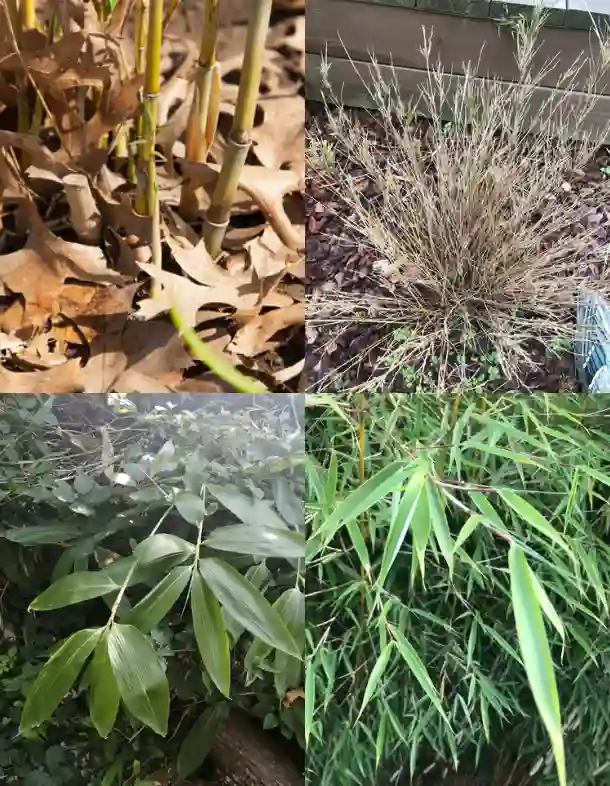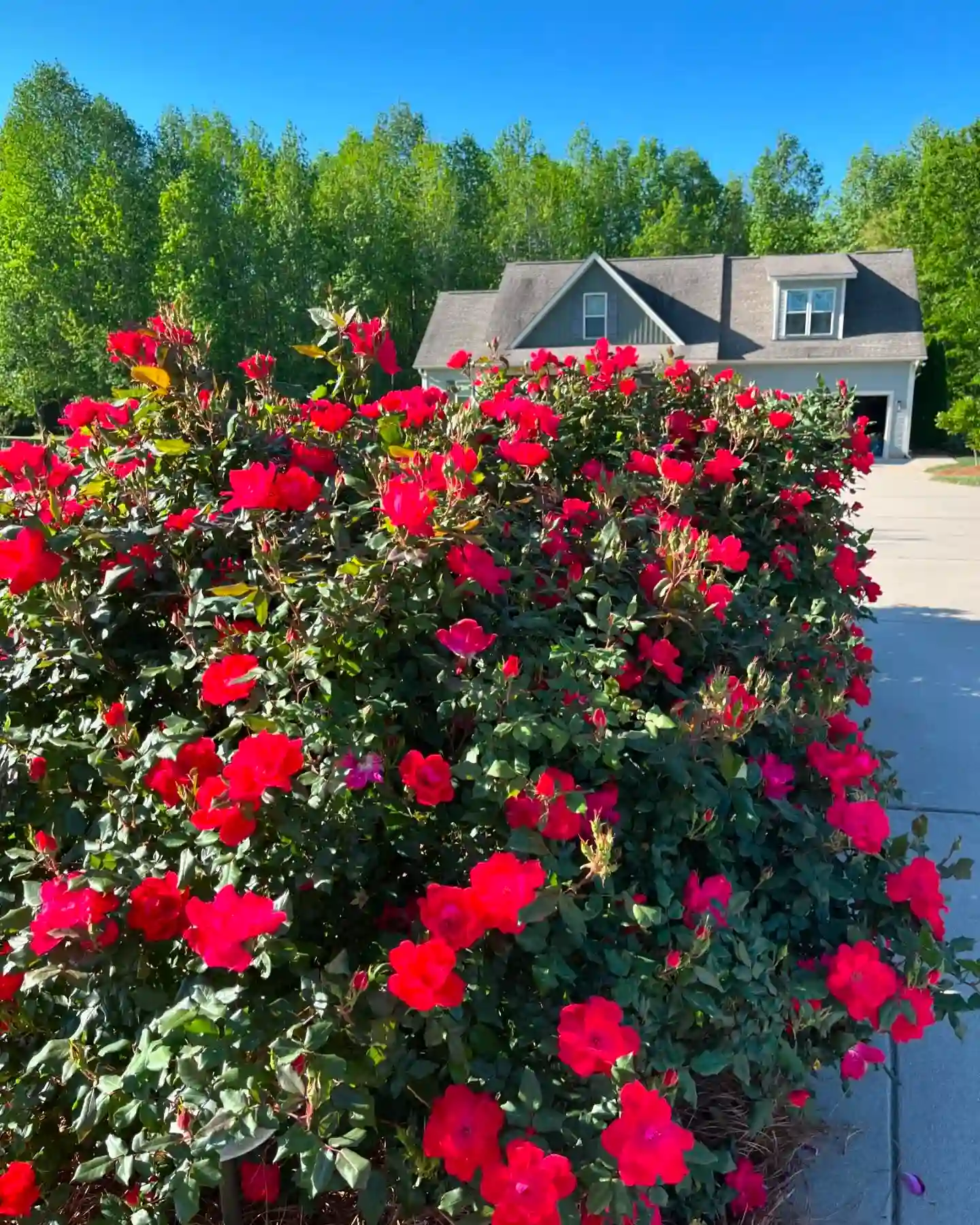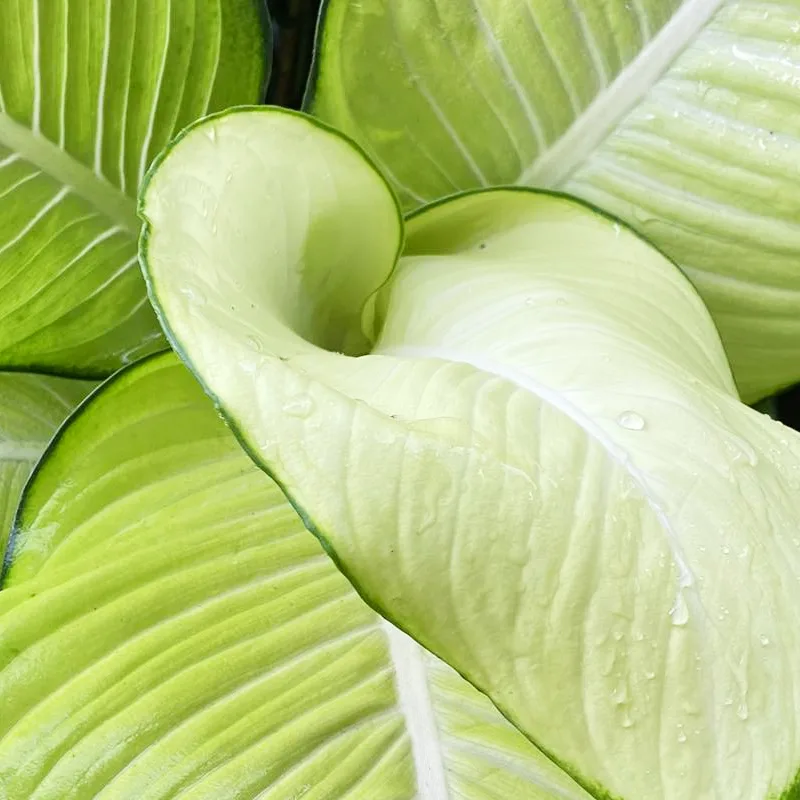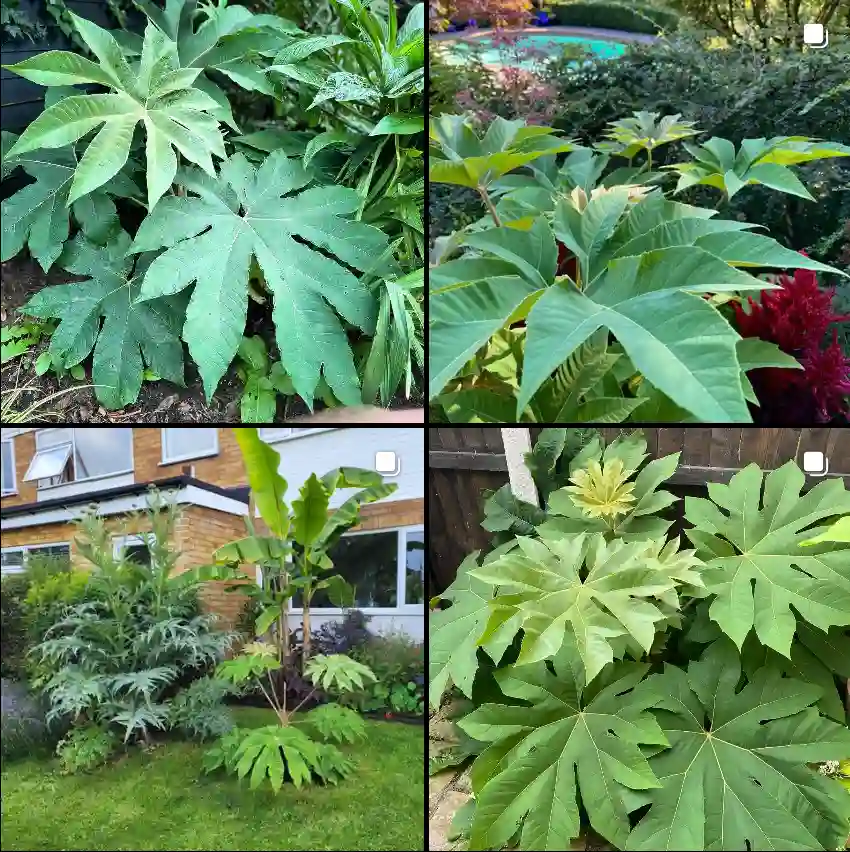Begonia Sinbad is a highly esteemed cane-stemmed Begonia (often referred to as an Angel Wing Begonia), cherished for its unique and captivating foliage. This hybrid cultivar boasts an enchanting metamorphosis of leaf color, emerging in delicate pink and bronze tones before maturing to a stunning silvery-green adorned with darker, speckled veining. Complementing its exquisite leaves are subtle clusters of pink flowers, adding a touch of understated elegance. ‘Sinbad’ offers a refined presence to indoor spaces, patio containers, and shaded garden beds, making it a favorite for those who appreciate nuanced beauty and structural form in their plants.
Unveiling the Charm: Characteristics of Begonia ‘Sinbad’
‘Sinbad’ is a hybrid cane-like Begonia, specifically a cross between Begonia dipetala (a thick-stemmed species) and a shrubby cane-type hybrid known as ‘U062’. This lineage contributes to its robust, upright habit and unique foliage characteristics. The cultivar ‘Sinbad’ was registered by Steward in 1997.
Key Characteristics of Begonia ‘Sinbad’:
- Color-Changing Foliage: Its most distinctive feature is the dynamic leaf coloration. New leaves emerge with charming pink and bronze tones. As they mature, they transform into a striking silvery-green with a speckled overlay and often darker, more deeply colored veining, truly showcasing its cane Begonia heritage. The undersides of the leaves often retain a pinkish-golden hue with darker pink margins.
- Leaf Texture: The small to medium-sized leaves have a pebbled surface, adding to their tactile and visual appeal.
- Cane-like Stems: Develops sturdy, upright, bamboo-like stems typical of cane Begonias. These stems contribute to its upright, bushy habit and can reach heights of 2−3 feet (60−90 cm), with a similar spread.
- Delicate Pink Flowers: Produces loose, pendant, axillary clusters of small, pink flowers. While not as flashy as some other Begonias, these seasonal blooms provide a charming contrast to the complex foliage, sometimes appearing to hide beneath the more vibrantly colored leaves. Blooms seasonally, often in summer, but can flower in winter and spring in optimal indoor conditions.
- Fibrous Roots: Like other cane Begonias, it possesses a fibrous root system. It is generally grown as a tender perennial, requiring overwintering indoors in colder climates (USDA Zones 10-11).
- Antique Variety: ‘Sinbad’ is considered an antique variety, valued for its classic beauty and enduring appeal.
Comprehensive Care Guide for Begonia ‘Sinbad’
Successfully cultivating Begonia ‘Sinbad’ requires providing consistent warmth, appropriate light to enhance its foliage colors, and balanced moisture, mimicking its tropical origins.
1. Light Requirements
- Bright, Indirect Light to Part Shade: Begonia ‘Sinbad’ thrives in bright, indirect light. This is crucial for developing and maintaining the vibrant pink and silver tones in its foliage without causing leaf burn. It can tolerate part shade.
- Optimal Placement: Indoors, an east or north-facing window is ideal, providing gentle morning sun or consistent filtered light. If placed near a south or west-facing window, use sheer curtains or position the plant further away to diffuse intense midday and afternoon sun, which can scorch its leaves.
- Foliage Coloration: Adequate bright, indirect light is essential for its unique color development. In insufficient light, the unique tones may fade, becoming more uniformly green, and the plant can become leggy.
- Airflow: Ensure good air circulation around the plant, especially in humid conditions, to help prevent fungal issues.
2. Watering
- Consistently Moist, Never Soggy: ‘Sinbad’ prefers consistently moist soil but is highly susceptible to root rot if the soil remains waterlogged.
- Check Before Watering: Allow the top 1−2 inches (2.5−5 cm) of the soil to dry out between waterings. The frequency will depend on factors like temperature, light intensity, pot size, and ambient humidity. It is said to “love water” but also to be “extremely easy to overwater,” so finding the right balance is key.
- Thorough Soaking and Drainage: When watering, do so thoroughly until water drains from the bottom of the pot. Always use containers with excellent drainage holes and promptly empty any excess water from saucers.
- Avoid Wetting Foliage: It is crucial to water at the soil level to keep the leaves dry. Water sitting on the pebbled foliage, especially in humid conditions, can easily lead to bacterial leaf spots or fungal issues like powdery mildew.
- Drought Tolerance (Short Periods): It can tolerate short periods of drought, but consistent moisture yields the best results. Drooping leaves can signal thirst.
3. Soil and Potting
- Well-Draining, Rich, and Aerated Mix: Begonia ‘Sinbad’ thrives in a fertile, well-draining potting mix that is rich in organic matter and provides good aeration for the roots.
- Recommended Mix: A high-quality commercial potting mix for houseplants or Begonias, amended with perlite, vermiculite, coco coir, or even some pine bark, will provide the ideal balance of moisture retention and drainage. A slightly acidic to neutral pH (6.0−7.0) is generally preferred.
- Pot Selection: Choose pots with adequate drainage holes. Cane Begonias generally appreciate being slightly root-bound, so select a pot that is only slightly larger than its current root ball when repotting. Terracotta pots can help balance moisture by allowing excess evaporation.
4. Temperature & Humidity
- Consistent Warm Temperatures: Begonia ‘Sinbad’ thrives in consistent warm temperatures, ideally between 65∘F and 75∘F (18∘C to 24∘C). It is not frost-hardy and will suffer if temperatures drop below 50∘F (10∘C).
- Avoid Fluctuations and Drafts: Protect the plant from sudden temperature fluctuations and cold drafts from windows, doors, or air conditioning vents, as consistency is vital for its delicate nature.
- Moderate to High Humidity: This Begonia appreciates moderate to high humidity levels (ideally 40-60%). While it can do well in average household humidity, higher levels will promote lusher growth and may help prevent crisping of leaf edges.
- Methods to Increase Humidity: Use a room humidifier, place the pot on a pebble tray filled with water (ensure the pot is not sitting in water), or group plants together to create a microclimate. Avoid frequent misting directly on the leaves.
- Balance Humidity with Air Circulation: Good, gentle air circulation is important even in high humidity to prevent stagnant air, which can lead to fungal issues like mildew.
5. Fertilization
- Regular Feeding During Growing Season: To support its robust growth and continuous flowering, ‘Sinbad’ benefits from regular fertilization during its active growing season (spring through fall).
- Recommended Regimen: Apply a balanced, water-soluble liquid fertilizer (e.g., NPK 15-15-15) every two to four weeks, diluted to half or quarter strength. Some sources suggest using a higher phosphorus fertilizer in early spring to encourage blooming.
- Reduce in Dormancy: Reduce or cease fertilization entirely in late fall and winter when the plant’s growth naturally slows down. Avoid over-fertilizing, which can cause root burn or leggy stems.
6. Pruning and Maintenance
- Pinching for Bushiness: Pinch back the tips of young stems to encourage bushier growth and a fuller plant. This helps maintain its compact form and prevents it from becoming leggy, especially if light is insufficient.
- Remove Damaged/Withered Foliage: Promptly remove any dead, dying, or yellowing leaves and withered flowers to maintain plant health and aesthetic appeal. This is crucial for preventing fungal issues.
- Sterile Tools: Always use clean, sharp, sterilized tools for any pruning to prevent the introduction and spread of pathogens.
- Staking (Optional): As a cane Begonia, taller specimens might benefit from a subtle bamboo or plant stake to provide support and maintain an upright form, especially if their canes become brittle or top-heavy with foliage.
Propagation: Multiplying the Silvery Beauty
Begonia ‘Sinbad’ can be relatively easily propagated through stem cuttings. Leaf cuttings can also be effective.
- Stem Cuttings (Most Common & Reliable):
- Select Cuttings: Choose healthy stem sections that are about 4−6 inches (10−15 cm) long, ideally in late spring or early summer.
- Preparation: Make a clean cut just below a leaf node. Remove any leaves from the bottom 1−2 inches (2.5−5 cm) that would be submerged in the rooting medium.
- Rooting Medium: Insert the cutting directly into a moist, well-draining rooting medium (e.g., sphagnum moss, perlite, or a light Begonia mix). Rooting hormone can be used to improve success rates. Cuttings can also be rooted in water, and while convenient, transferring to soil after roots are 1-2 inches long is recommended for better long-term establishment.
- Environment: Provide warm temperatures (68−75∘F or 20−24∘C) with bright, indirect light. High humidity (e.g., within a clear plastic bag or propagation dome) is beneficial for rooting.
- Rooting & Transplanting: Roots typically develop within a few weeks. Once well-rooted and new growth appears, the new plant can be carefully transplanted into a larger pot with its preferred substrate.
- Leaf Cuttings:
- Method: Cut a healthy leaf (with or without a petiole). If with a petiole, insert it into moist rooting medium. If without, make cuts along the main veins on the underside of the leaf and lay the leaf flat on the rooting medium, ensuring good contact.
- Environment: Provide warmth and high humidity. This method can take longer for plantlets to form.
Overwintering Begonia ‘Sinbad’
As a tender perennial, Begonia ‘Sinbad’ is not frost-hardy and is typically grown as an annual in climates with freezing winters (below USDA Hardiness Zone 10-11). However, it can be successfully overwintered indoors.
- Bring Indoors Before Frost: Before the first hard frost or when nighttime temperatures consistently drop below 50∘F (10∘C), bring potted plants indoors.
- Indoor Care: Place the plant in a bright location with indirect light. Reduce watering frequency, allowing the top couple of inches of soil to dry out almost completely between waterings. Growth will slow significantly, and flowering will likely cease. Maintain good air circulation around the plant. It may experience some leaf drop upon moving indoors due to environmental shock.
- Taking Cuttings: A highly reliable method for ensuring future plants is to take stem cuttings in late summer or early fall and root them indoors. These younger plants are often easier to maintain over winter and will perform vigorously the following spring.
Common Pests and Diseases
‘Sinbad’ is generally robust, but like all Begonias, it can face some common challenges, especially if cultural conditions are not optimal.
- Pests:
- Mealybugs, Spider Mites, Aphids, Thrips, Whiteflies: Inspect plants regularly, particularly the undersides of leaves and new growth. Treat with insecticidal soap or neem oil at the first sign of infestation. Good air circulation can help deter some pests.
- Slugs and Snails: Can be an issue for outdoor plants in moist conditions.
- Diseases:
- Root Rot / Stem Rot: The most common problem, almost always due to overwatering or poorly draining substrate. Leads to wilting, yellowing leaves, and mushy stems. Ensure excellent drainage and allow soil to dry slightly between waterings.
- Powdery Mildew: White, powdery spots on leaves and stems. Favored by high humidity with poor air circulation and cool temperatures. Improve airflow, avoid overhead watering. Avoid composting infected plants.
- Botrytis Blight (Gray Mold): Fuzzy gray or brownish patches, often on decaying plant matter or in damp, cool, crowded conditions. Remove affected parts immediately and improve ventilation.
- Bacterial Leaf Spot: Dark, water-soaked spots on leaves, often due to water sitting on foliage. Avoid overhead watering.
- Leaf Browning/Crisping: Can be caused by underwatering or insufficient humidity.
- Leaf Drop: Often due to environmental shock (e.g., moving indoors), inconsistent watering, or low light levels.
- Leggy Growth: Due to insufficient light.
Prevention is Key: Optimal watering practices, ensuring good air circulation, using appropriate well-draining soil, and regular inspection are the best defenses against most problems. Promptly address any issues to prevent them from spreading.
Design Ideas and Companion Plants for Begonia ‘Sinbad’
The elegant variegated foliage and upright habit of ‘Sinbad’ make it a beautiful addition to various indoor and shaded outdoor displays.
- Indoor Specimen Plant: Its unique, color-shifting foliage makes it a stunning standalone houseplant for shelves, side tables, or plant stands where its intricate leaves can be admired up close.
- Mixed Containers (Shaded Patio): Combine with other shade-loving plants in patio containers. Its upright habit can serve as a “filler” or “thriller,” complemented by lower-growing or trailing plants.
- Terrariums/Plant Cabinets: Its preference for moderate to high humidity and indirect light makes it a suitable candidate for larger terrariums or plant cabinets, where environmental conditions are controlled.
- Border Edging (Warm Climates): In frost-free zones, it can be used as a striking border plant in shaded garden beds.
- Companion Plantings (Shade):
- Foliage Contrast: Pair with plants that offer contrasting leaf shapes or colors, such as fine-leafed ferns, vibrant green Fittonia, or various Caladiums (especially with white or pink hues).
- Floral Harmony: Delicate miniature Orchids or other small, shade-loving flowering plants can complement its subtle pink blooms.
- Textural Play: Combine with mosses or other ground covers for a layered look.
Begonia ‘Sinbad’ vs. Other Popular Begonia Types
Understanding where ‘Sinbad’ fits within the diverse Begonia genus highlights its unique attributes, particularly its distinctive foliage and cane-stemmed growth.
- Begonia ‘Sinbad’ (Cane Begonia / Angel-Wing type):
- Key Differentiator: Color-changing foliage (pink/bronze to silvery-green with speckles); pebbled leaf texture; upright cane-like stems; delicate pink flowers.
- Foliage: Highly ornamental, variegated, textured, dynamic color.
- Growth Habit: Upright, cane-stemmed, bushy.
- Root System: Fibrous.
- Light: Bright, indirect light to partial shade.
- Humidity: Moderate to high (40-60%) is appreciated.
- Primary Use: Indoor specimen, patio containers, shaded outdoor containers.
- Begonia maculata (Angel Wing Begonia / Cane Begonia):
- Key Differentiator: Large, dark green leaves with bold, contrasting white or silver polka dots on the upper surface and reddish undersides.
- Foliage: Polka-dotted, distinctive “angel wing” shape.
- Growth Habit: Upright, cane-stemmed.
- Light: Bright, indirect light.
- Distinction from ‘Sinbad’: ‘Maculata’ has distinct, larger polka dots versus ‘Sinbad’s’ silvery splashes and pebbled texture. ‘Sinbad’ also has a more pronounced color change in its new growth.
- Begonia ‘Sierra Gentle Rain’ (Cane Begonia / Angel-Wing type):
- Key Differentiator: Deeply lobed, olive-green leaves with distinctive silvery splashes; unique leaf indentations.
- Foliage: Highly ornamental, variegated, deeply textured.
- Light: Bright, indirect light to partial shade.
- Distinction from ‘Sinbad’: ‘Sierra Gentle Rain’ is characterized by its deep lobing and overall “rain-spattered” effect, differing from ‘Sinbad’s’ color-changing, pebbled surface.
- Begonia darthvaderiana (Petermannia Section):
- Key Differentiator: Dramatic near-black leaves with a sharp lime-green/silvery edge; dark red undersides; highly demanding extreme humidity (90-100%).
- Foliage: Striking, velvety, asymmetrical, oblong-ovate.
- Growth Habit: Erect stem, shrub-like.
- Light: Low to intermediate, bright indirect.
- Primary Use: Advanced collector’s plant for terrariums/plant cabinets.
- Begonia Thelmae (Trailing/Scandent):
- Key Differentiator: Delicate trailing/vining habit; relatively small, often textured leaves; dainty white/pale pink flowers; demands very high humidity.
- Foliage: Small to medium, ovate to heart-shaped, subtle texture/color.
- Growth Habit: Trailing, vining, can be scandent.
- Light: Bright, indirect light.
- Humidity: Extremely high (70%+) is crucial.
- Primary Use: Terrariums, hanging baskets, specialized indoor displays.
- Rex Begonias ( Begonia rex-cultorum – Rhizomatous):
- Key Differentiator: Grown for highly ornamental, often metallic, variegated, intricately patterned foliage; wide range of non-iridescent colors; typically larger leaves.
- Foliage: Highly diverse patterns, textures, and colors.
- Flowers: Small, inconspicuous.
- Growth Habit: Compact to spreading, grows from creeping rhizomes.
- Light: Bright, indirect light.
- Humidity: Prefer high humidity.
- Primary Use: Houseplants for decorative foliage, terrariums.
Toxicity of Begonias
Important Note: All Begonias, including Begonia ‘Sinbad’, contain insoluble calcium oxalates, making them toxic to pets (dogs and cats) if ingested. The highest concentration of these toxic compounds is generally found in the roots. Ingestion can lead to:
- Intense burning and irritation of the mouth, tongue, and throat.
- Excessive drooling.
- Vomiting.
- Difficulty swallowing.
- Lack of appetite.
While usually not life-threatening due to the immediate discomfort that deters further ingestion, it’s crucial to keep these plants out of reach of curious pets and small children. In rare, large ingestions, more severe symptoms like kidney failure have been reported. For humans, the toxicity is generally considered mild, but ingestion of any plant material is not recommended. Always contact a veterinarian immediately if you suspect your pet has ingested any part of the plant.
Conclusion
Begonia ‘Sinbad’ is a truly captivating Angel Wing Begonia that offers a unique and dynamic display of foliage coloration. Its elegant blend of pink, bronze, and silvery-green hues, combined with a sturdy upright habit and delicate pink blooms, makes it a sophisticated choice for any plant enthusiast. While it appreciates consistent warmth, bright indirect light, and moderate to high humidity, its relatively low-maintenance nature for such a striking plant makes it a rewarding addition. Whether gracing an indoor shelf, a patio container, or a shaded garden bed, ‘Sinbad’ promises to infuse your space with its distinctive charm and ever-changing beauty.
If i die, water my plants!



